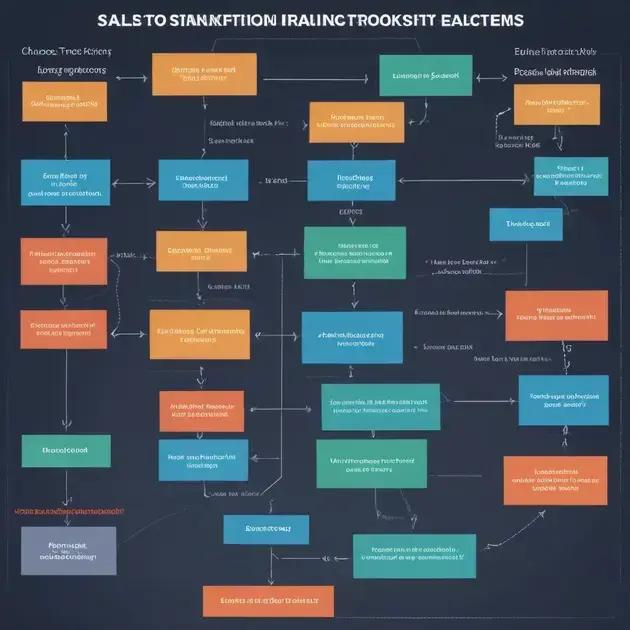A sales tracking system is a crucial tool for businesses, enabling effective monitoring of sales processes, enhancing team collaboration, and providing data-driven insights to improve performance and drive sales growth.
Sales tracking systems are game-changers for businesses looking to elevate their sales performance. By automating and streamlining the sales process, these systems provide insights and data that can significantly enhance decision-making. In this article, we’ll dive into what you need to know about sales tracking systems, their benefits, and tips for selecting one that matches your business needs.
Understanding Sales Tracking Systems
A sales tracking system is a vital tool that helps businesses monitor their sales processes. These systems enable sales teams to collect, analyze, and manage sales data effectively. By understanding how sales tracking works, businesses can optimize their strategies and improve their overall sales performance.
What is a Sales Tracking System?
A sales tracking system is designed to record every sales interaction, from initial contact to the final sale. It includes data like customer information, sales stages, and outcomes. This allows businesses to see where they excel and where they need improvement.
Key Components of Sales Tracking Systems
Most sales tracking systems have several important features. They often include customer relationship management (CRM) tools, reporting dashboards, and sales pipeline tracking. These components work together to provide a complete picture of the sales process.
How Sales Tracking Systems Improve Efficiency
By using a sales tracking system, teams can quickly identify leads, manage follow-ups, and analyze sales patterns. This data-driven approach ensures that no opportunities are missed and helps in prioritizing leads that are more likely to convert.
The Importance of Accurate Data
Accurate data is crucial for effective sales tracking. A robust system helps maintain data integrity, ensuring that sales teams can rely on the information presented. This leads to more informed decision-making and better strategies moving forward.
In conclusion, implementing a sales tracking system can greatly enhance your business’s ability to analyze and improve its sales performance. Understanding its functionalities and benefits is the first step toward leveraging it effectively.
Benefits of Implementing a Sales Tracking System

Implementing a sales tracking system offers numerous benefits that can significantly enhance a business’s sales performance. These systems enable better organization, visibility, and analysis of sales activities, which leads to improved decision-making.
Improved Sales Visibility
One of the most significant advantages is improved visibility into sales processes. Sales teams can track their performance in real-time, understanding where each deal stands and identifying which leads need more attention. This transparency helps prioritize efforts on high-potential opportunities.
Data-Driven Insights
Sales tracking systems collect valuable data that can be analyzed to uncover trends and insights. This data helps in understanding customer behaviors, preferences, and buying patterns. Businesses can leverage these insights to tailor their sales strategies effectively.
Enhanced Communication and Collaboration
With a sales tracking system, communication among team members improves. Everyone has access to the same information, allowing for better collaboration. Teams can share insights, strategies, and updates without confusion, leading to a more synchronized sales effort.
Accountability and Performance Measurement
Sales tracking systems help establish accountability within the team. By monitoring individual and team performance, managers can identify top performers and those who need additional support. This clarity fosters a culture of accountability and drives overall improvement.
Time Savings and Efficiency
Automating the tracking of sales activities saves time for sales teams. Instead of spending hours on manual tracking and reporting, they can focus on what they do best: selling. This increased efficiency leads to more closed deals and higher productivity.
Top Features to Look for in a Sales Tracking System
When choosing a sales tracking system, it is essential to consider key features that will best support your business needs. The right system can make a significant difference in your sales processes and results.
CRM Integration
A good sales tracking system should integrate seamlessly with Customer Relationship Management (CRM) tools. This allows sales teams to manage customer interactions efficiently, ensuring all information is consolidated in one place.
Customizable Dashboards
Look for a system with customizable dashboards. This feature enables users to view metrics that matter to them, making it easier to analyze performance and track progress at a glance. Team members can tailor their dashboards to focus on their specific goals.
Sales Pipeline Management
The ability to manage your sales pipeline is crucial. A robust sales tracking system provides visual representations of the sales process, helping teams understand where each deal stands. This insight leads to better forecasting and more effective follow-up strategies.
Automated Reporting
Automated reporting features save time and reduce errors. A good system will generate reports on sales performance, trends, and forecasting automatically. This allows teams to focus on analyzing data rather than compiling it.
Mobile Accessibility
Since many sales professionals work on the go, a sales tracking system should offer mobile accessibility. Mobile apps enable users to access real-time data, update information, and respond to leads anywhere, keeping the sales process agile.
How to Choose the Right Sales Tracking System

Choosing the right sales tracking system is essential for optimizing your sales processes. Here are several key factors to consider when making your selection.
Identify Your Business Needs
Before selecting a system, take time to assess your specific business needs. Consider the size of your team, the volume of sales, and your industry requirements. This information will guide you in choosing a system that fits your workflow.
Set a Budget
Determining a budget is crucial. Sales tracking systems can vary widely in cost, so establish what you can afford. Remember to factor in the total cost of ownership, including licenses, implementation, training, and ongoing support.
Evaluate Features and Functionality
Look at the features that each sales tracking system offers. Essential functions include CRM integration, sales pipeline management, reporting tools, and mobile accessibility. Make sure the features align with your needs and will enhance your team’s productivity.
Read User Reviews and Test Demos
User reviews are valuable sources of feedback. Explore what current users say about their experiences with various systems. Many providers also offer free trials or demos, which can help you assess if the system meets your expectations.
Consider Scalability
As your business grows, your sales tracking needs may change. Choose a system that can easily scale with your organization. This flexibility will save you time and money in the long run, preventing the need for frequent system upgrades.
Common Mistakes in Sales Tracking and How to Avoid Them
When implementing a sales tracking system, it’s important to avoid common mistakes that can hinder effectiveness. Here are some pitfalls to watch out for and tips on how to avoid them.
Neglecting Data Quality
One of the biggest mistakes is ignoring the importance of data quality. Inaccurate or outdated data can lead to poor decisions. Ensure that your team regularly reviews and cleans the data entered into the system to maintain its integrity.
Overcomplicating the Process
Sometimes, sales tracking systems can become overly complicated. If the system is difficult to use, team members may avoid using it altogether. Keep the user interface simple and intuitive. Provide adequate training to help your team feel comfortable with the system.
Failing to Set Clear Goals
Without clear goals, it’s hard to measure success. Define what you want to achieve with your sales tracking system. This could be improving lead conversion rates, shortening the sales cycle, or increasing customer retention. Having clear goals will help focus your efforts.
Ignoring Team Feedback
Your sales team is the primary user of the tracking system, so their feedback is crucial. Regularly ask for their input on the system’s functionality and gather suggestions for improvement. Involving your team in the decision-making process fosters buy-in and improves the system’s effectiveness.
Neglecting Regular Training
Sales processes and tools are constantly evolving. Failing to provide ongoing training can leave your team behind. Schedule regular training sessions to ensure your team stays updated on best practices and new features of the sales tracking system.
The Importance of Effective Sales Tracking
Implementing a sales tracking system is crucial for any business looking to improve its sales processes. By understanding what a sales tracking system is and the benefits it can bring, you set the stage for success.
A well-implemented system helps your team stay organized, enhance communication, and make data-driven decisions. However, it’s important to avoid common mistakes that can limit effectiveness. Neglecting data quality, making processes too complex, and ignoring team feedback are pitfalls to watch out for.
By following best practices and continuously training your team, you can ensure that your sales tracking system works optimally. Remember, staying proactive about your sales strategies will not only lead to improvements but also help your business thrive in a competitive market.
FAQ – Frequently Asked Questions about Sales Tracking Systems
What is a sales tracking system?
A sales tracking system is a tool that helps businesses monitor and analyze their sales processes, including customer interactions, sales stages, and outcomes.
How can a sales tracking system improve my business?
It enhances visibility into sales performance, allows data-driven decision making, and helps your team prioritize leads more effectively.
What features should I look for in a sales tracking system?
Key features include CRM integration, customizable dashboards, sales pipeline management, automated reporting, and mobile accessibility.
Can sales tracking systems help increase sales?
Yes, by providing insights and organization, sales tracking systems can help identify opportunities and improve sales strategies.
How much should I expect to spend on a sales tracking system?
Costs can vary widely. It’s best to set a budget considering licensing, implementation, and training costs.
How do I train my team to use a sales tracking system effectively?
Provide regular training sessions, encourage feedback, and ensure they understand the system’s features and how it benefits their work.




